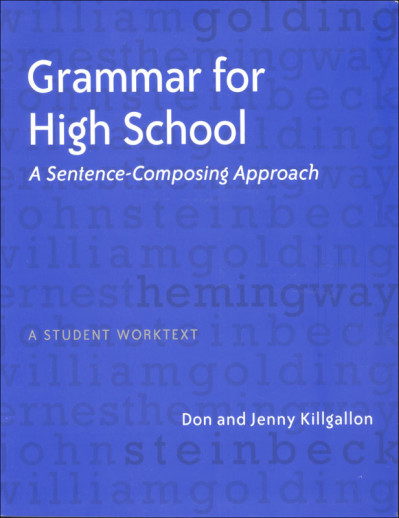We use cookies to make your experience better. To comply with the new e-Privacy directive, we need to ask for your consent to set the cookies. Learn more.
Grammar for High School
Build both an appreciation for the importance of grammar and an amazement at the creative possibilities for employing it with this course. Identifying fourteen grammatical tools that fall under the general categories of words, phrases, and clauses, each is given its own instructional practice section. Each Tool is concisely defined and illustrated with numerous examples from professional authors. Practices are introduced by a matching activity; then completed using sentence-composing techniques – unscrambling, combining, imitating, and expanding. Famous authors' use of each type of tool serves as a review: Harper Lee (words), John Steinbeck (phrases), and Ernest Hemingway (clauses). After each review section, a creative writing activity gives the student the opportunity to apply what they have learned. ~ Janice
Across America, in thousands of classrooms, Don and Jenny Killgallon's sentence-composing approach has given students tools to become more proficient, sophisticated writers. Now the Killgallons present the first-ever high school grammar book that teaches grammar through sentence composing. Grammar for High School: A Sentence-Composing Approach gives students the chance to absorb and replicate the grammar used in some of the finest novels, including student favorites and curricular standbys such as John Steinbeck's Of Mice and Men, Harper Lee's To Kill a Mockingbird, Ernest Hemingway's The Old Man and the Sea, and William Golding's Lord of the Flies.
Fourteen grammatical structures are developed as writing tools in an accessible, understandable, and similar manner through the sentence-composing approach. For each structure students will:
* learn a clear definition of its characteristics and function
* practice it through five guided sentence-composing activities
* deepen their understanding through an independent creative writing activity
* vary the tools through multiplying and combining them.
Students and teachers will quickly discover how powerful the sentence-composing approach can be for learning grammar—and for raising students' writing abilities to new, exciting levels.
A perfect melding of grammar, composition, and literature, the sentence-composing method starts with high quality sentence models from literary masters and then carefully gives students specific tools and the opportunity to practice using those tools throughout a series of books. As you would expect with any organic methodology, there is both a cohesion and an expansion through the Elementary, Middle School, and High School courses. Each are targeted with a progression of skill-building that focuses on and starts with sentences, dissects and uses grammar, and builds into composing coherent communications.
Central to all levels, is the use of writing models – sentence examples from a huge collection of best-loved and critically acclaimed writers. Think of these writers as mentors and the process of unpacking, manipulating, and imitating their sentences as a personal tutorial in the art of composition. Sentences from hundreds of writers are matched to grade level by familiarity with their works. For instance, in elementary courses you might see Katherine Patterson or Roald Dahl. In middle school it might be Jack London, Madeleine L'Engle, JK Rowling, or even Stephen King. In high school you will find Harper Lee, George Orwell, or Maya Angelou.
Multiple techniques (tools) are taught and practiced. Some of these include matching, exchanging, unscrambling, combining, imitating, expanding, and multiplying. Each tool/technique is explained and illustrated using sample sentences. Often, the underlying grammatical constructs are examined as well. The student undertakes step-by-step tasks and benefits from the clearly stated imitating expectations – and may well be surprised by the high quality of compositional results. Where possible and useful, "reference" sections in the back of books serve as an answer key.
This series has grown and matured over time. Sentence Composing was the first (late 90s); Getting Started and the other courses are a parallel series that emerged over the next two decades (2006-2020). These later sets of series expand concepts introduced in the original Sentence Composing. The Grammar series delves a little deeper into the grammar aspects (2006-2008). Paragraphs (2012-14) and Nonfiction (2015-2017) expands sentence composing techniques to particular types of composition. The newest series is the Getting Started series (2018-2020) which serves as an introduction to the sentence composing method. All volumes are by Don and Jenny Killgallon and share a focus on sentence composing (the most neglected aspect of written composition). All use model/mentors based on the belief that imitation is the conduit to originality; a needed link in creation.
It may be a little confusing to know when to use what course. In general, use the original Sentence Composing course as a summary course for a student that is in the upper level of the grade range. For instance, 4th/5th grade for the Elementary; 7th/8th grade for the Middle School. If your student is in the lower levels of the grade range (i.e. 2nd/3rd; 5th/6th) use the Getting Started book and work through the series.
Each of the sentence composing method worktexts is a stand-alone course designed to produce sentence maturity and variety and would serve as the composition/applied grammar portion of a language arts program. For elementary years, add phonics/reading, spelling, and handwriting. For middle school years, add literature and possibly a systematic grammar. For the high school years, if coupled with a literature program, the series serves as an English credit. ~ Janice
| Product Format: | Paperback |
|---|---|
| Brand: | Heinemann Publishing |
| Grades: | 9-12 |
| ISBN: | 9780325010465 |
| Length in Inches: | 11 |
| Width in Inches: | 8.5 |
| Height in Inches: | 0.375 |
| Weight in Pounds: | 0.95 |

